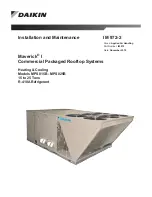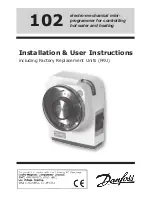
Mechanical Installation
www.DaikinApplied.com
9
IM 972-2 • MAVERICK I ROOFTOP SYSTEMS
Ducting
DANGER
Never connect return ductwork to any other heat producing device such as
fireplace insert, stove, etc. Unauthorized use of such devices may result
in fire, carbon monoxide poisoning, explosion, personal injury, property
damage or death.
NOTICE
In the event that the return air ducts must be run through an “unconfined”
space containing other fuel burning equipment, it is imperative that the user
be informed against future changes in construction which might change this
to a “confined space.” Also, caution the user against any future installation
of additional equipment (such as power ventilators), within the existing
unconfined and/or confined space which might create a negative pressure
within the vicinity of other solid, liquid, or gas fueled units.
The installing contractor should fabricate ductwork in
accordance with local codes. Use industry manuals as a
guide when sizing and designing the duct system. Contact
Air Conditioning Contractors of America, 1513 16th St. N.W.,
Washington, D.C. 20036.
Place the unit as close to the conditioned space as possible
allowing clearances as indicated. Run ducts as directly as
possible to supply and return outlets. Use of non-flammable
weatherproof flexible connectors on both supply and
return connections at unit to reduce noise transmission is
recommended.
On ductwork exposed to outside temperature and humidity,
use a minimum of 2" of insulation and a vapor barrier.
Distribution system in attic, furred space or crawl space should
be insulated with at least 2" of insulation. Half-inch to 1"
thick insulation is usually sufficient for ductwork inside the air
conditioned space.
Provide balancing dampers for each branch duct in the supply
system. Properly support ductwork from the structure.
Return Air
DANGER
Never allow products of combustion or the flue products to enter the return
air ductwork, or the circulating air supply. All return ductwork must be
adequately sealed and secured to the furnace with sheet metal screws and
joints must be taped. All other duct joints must be secured with approved
connections and sealed airtight.
Failure to prevent products of combustion from being circulated into the
living space can create potentially hazardous conditions, including carbon
monoxide poisoning that could result in personal injury or death.
Gas Supply, Condensate Drain
Gas Connection
IMPORTANT
Connect this unit only to gas supplied by a commercial utility.
DANGER
Never test for gas leaks with an open flame. It can cause an explosion or fire
resulting in property damage, personal injury or death. Use a commercially
available soap solution made specifically for the detection of leaks to check
all connections as specified in the “Mechanical Installation” section of these
instructions.
1. Install gas piping in accordance with local codes and
regulations of the local utility company. In the absence
of local codes, the installation must conform to the
specifications of the National Fuel Gas Code, ANSI
Z223.1 - latest edition.
NOTE:
The use of flexible gas connectors is not permitted.
2. Connect the gas line to the gas valve supplied with unit.
Routing can be through the gas pipe opening shown in
or through the base as shown in
.
3. Size the gas line to the furnace adequate enough to
prevent undue pressure drop and never less than 1/2".
4. Install a drip leg or sediment trap in the gas supply line
as close to the unit as possible.
5. Install an outside ground joint union to connect the gas
supply to the control assembly at the burner tray.
6. Gas valves have been factory installed. Install a manual
gas valve where local codes specify a shut-off valve
7. Make sure piping is tight. A pipe compound resistant to
the action of liquefied petroleum gases must be used at
all threaded pipe connections.
8.
IMPORTANT:
Any additions, changes or conversions
required for the furnace to satisfactorily meet the
application should be made by a qualified installer,
service agency or the gas supplier, using factoryspecified
or approved parts. In the commonwealth of
Massachusetts, installation must be performed by a
licensed plumber or gas fitter for appropriate fuel.
Summary of Contents for Maverick I
Page 51: ......










































